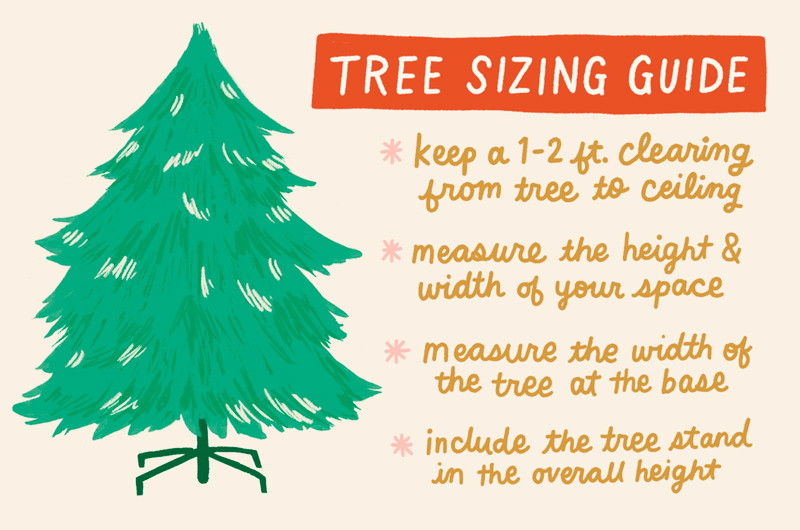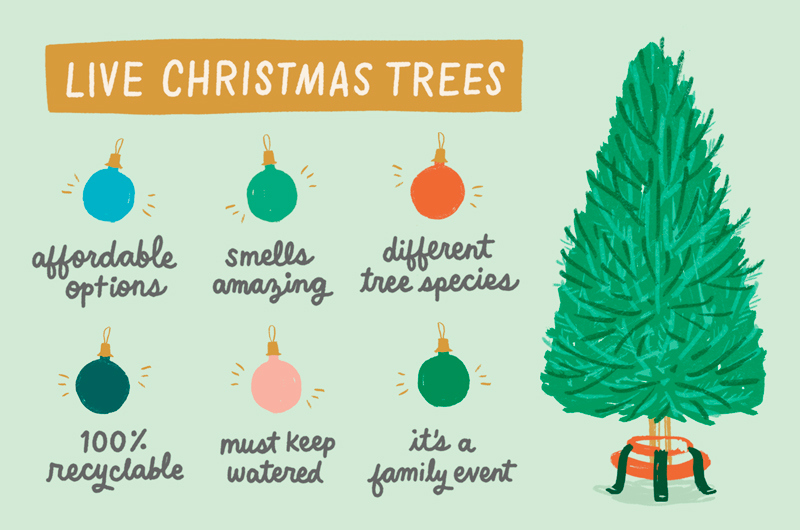When it comes to deciding between real or artificial Christmas trees, you’ll often hear people say there’s nothing like a live Christmas tree. And those people are right.
Ooooh, that smell! The soft feel of the needles. The body-mind health aspects of having a 6–10-foot living plant in your space. So. Good.
If you’re on the fence about a live tree for environmental reasons, know that live trees can be decorated beautifully for the season and then put back to work for the environment. For instance, if you buy a tree with a root ball, it can be replanted.
And real trees are entirely biodegradable. A lot of organizations will take trees to convert into mulch or composted soil after Christmas. And some farms, zoos and petting zoos will take your tree as an after-Christmas treat for animals like pigs, camels, elephants and goats.
More Environmental Benefits to Choosing a Live Tree
It takes 8–10 years for a Christmas tree to grow. During that time, they’re our breathing buddies, creating oxygen from carbon dioxide. They also filter water, reducing runoff and potential flooding, and provide shelter and protection for wildlife as parts of sustainably managed forests.
What to Look for in a Live Tree
Budget
There are a lot of affordable options with live trees, like firs, pines and spruces. When you go to the live tree lot to pick out a Christmas tree, they are generally arranged by price and type to make your selection easier. If budget is your first consideration (like it is mine), it’s not hard to find a pretty tree for your penny.
Strength
When buying a Christmas tree, take your time to feel the boughs and needles to see if they will support the types of ornaments and lights you want to hang. Some trees with softer needles and slimmer boughs will only support smaller ornaments, unless you support them with thin fishing line. And some trees will dictate to you where the ornaments and lights will be placed. If you can, bring an ornament or two with you to see which tree gives you the best hang.
Fullness
So, yup, when I choose a live tree, I give it the “ornament test.” But I also have someone else hold the tree up tall so that I can get a look at all sides. If you plan to put the tree in the middle of a room, know those angles, baby! You want it to look good from all sides to whoever is looking on the ’Gram and admiring it in your home.
Pro tip: Your tree only has to be good-looking on two or three sides if you plan to put it in a corner or on a wall. Any unfortunate side can stay a secret just between you and your tree.
Health
Also, when picking out a Christmas tree, give it a good shake to see how many needles are falling. You’re looking for resilience here. If the needles are dropping like screaming teens at a Harry Styles concert, your tree won’t likely make it through the season.
Don’t be that woman whose tree died two weeks before Christmas, who then had to remove every single light and ornament as she wept bitterly and transfer them to a Struggle Tree—the only sad and pitiful tree left on the live lot by then. (Yes. I’m also that woman.)
Species
So I learned the hard way to go for trees with durability. And now, when it comes to types of Christmas trees, I’m kind of a fir woman. Here’s how come:
- I like Fraser firs because they are beautiful, soft, very dark green, and have sturdier branches that can handle heavier ornaments and are most likely to have most of their needles at the end of celebration season.
- Balsam firs are also lovely. They have a cone shape with short, dense branches, dark green needles and a sweet foresty smell.
- It’s the Douglas fir for me though. Nothing beats that sweet, earthy, pine smell. Douglas firs generally have the perfect cone shape we’ve come to associate with Christmas trees, can handle lots of ornaments and lights, and endure the season well.
Pro Stylist Tip from Nicole: Another advantage of a live tree is that you can cut branches if you feel like the tree is a little too full or if you want to feature certain ornaments or other chosen elements. Thinning it a little can actually add longevity to the tree because it doesn’t have to support so many branches.
<
h2>Caring for a Live Tree
IMPORTANT NOTE: Water! Water! Water!
So remember that woman who ended up with the Struggle Tree when her original tree died two weeks before Christmas? (Again, that was me.) Nicole explained where I went wrong. A live tree has to be watered as soon as you get it home. Which I did. But that wasn’t enough.
Nicole suggests giving your tree a fresh cut once you get home or having it cut again just before you leave the lot. By the time you buy a Christmas tree, the initial cut has sealed and can’t take in the water the tree needs to thrive. Take off three to four inches of the trunk so that you can put fresh wood into fresh water. (Keep this cut in mind when deciding the height of your tree.) You can also buy liquid food to help preserve your tree.
Make Buying a Christmas Tree Your Family Thing
Finally, buying a live Christmas tree offers you an opportunity to make some of your sweetest family memories together. Gather your gang and ride to the lighted live lots around your town until you find the right tree. Grab some cocoa and other treats for the search. Let everyone vote on the tree that feels perfect for your family. Make a party of tying it to the car, driving it home, bringing it through the door and putting it up.
The Pros of Artificial Trees
Clearly, I think live trees are bombity.com. But I’m an equal opportunity tree-lover. Artificial trees, or “play trees” as I call them, can look just as beautiful, are easier in terms of maintenance, and last longer than live trees—several seasons in fact.
I like them because they don’t require watering and you can more easily manipulate branches and needles where you need them to go for optimal lighting and decoration treatments. Not to mention, there’s a whole lot of fun to be had in terms of style. Let me break it down…
Flexibility
Play trees accommodate every budget, from beginner to lottery winner, and come in a variety of colours, shapes and sizes.
You can buy green trees that look indistinguishable from any tree on a live lot. You can also get them in space-age colours like silver, gold or platinum, or fashion colours like hot pink, fuchsia and snow white. If your heart desires, you can find them in team colours like royal blue, yellow, orange or red.
You can even buy striped, polka-dotted and rainbow trees. Know what that means? You can make your joyful statement as subtly or as loud as you want to!
Play trees also give you a lot more options when it comes to size. I like pencil trees because they’re as tall as regular trees but take up much less floor space. They also happen to support my perspective that every room in the house can host a tree. Or two. Or four, depending on the room.
(Side note: If you’re worried about room, keep in mind that you will need somewhere to store an artificial tree.)
The deal on artificial Christmas tree sizes:
- Pencil trees can measure anywhere from 4–16 feet tall but take up only 18–23 inches of floor space.
- Slim trees are a little fuller at the base at 24–40 inches.
- Medium trees are between 40 and 54 inches in diameter.
- Full trees come in between 56 and 64 inches.
I use a mix of tree sizes in my home to create something special for every room, and my rooms never feel crowded. For instance, I use three pencil trees of varying heights and one full tree in my living room. It feels like a fairy-lit forest in the end.
But I am not judging people who feel like one Christmas tree per season is enough. Let your freak flags fly, one-treers! Again: Your season. Your celebration.
Pre-Lit Perfection
You can buy artificial trees with or without lights. I buy pre-lit trees for ease because lights are already attached to the tips of boughs. That means I don’t have to worry about unwinding endless strings of tangle-able lights and accidentally losing my religion in frustration. I also dig that there are fewer cords showing.
Having said that, I do love adding an extra string of lights or two for more glow and show. Another tip from Nicole: You don’t have to take off any lights you add to the tree. You can leave them on between seasons, making the setup for the next year easier.
Pro tip: If you’ve got your naked tree set up and it’s looking a little spare—especially if you’ve bought a less expensive tree—buy a couple of real or artificial garlands, depending on your tree type, to wrap around the trunk and fill in any obvious holes. Try to match your tree as closely as possible, but don’t worry if you don’t get a perfect match. A little contrast can add interest and beauty.
I do have one beef with artificial trees: I miss the smell of real trees.Nothing can replace that. But good news—You can get pretty close.
Here are a couple of hacks from me to you:
- Buy a real pine wreath to hang somewhere near your tree. The fresh aroma suffuses the room and adds a fresh outdoor Christmas feel.
- Tuck a scented pine cone deep into the back of your tree; the added scent is a bonus Christmas treat.
I discovered the pine cone thing last year when my family, apparently overcome by the blaring holly jolly of Christmas music in the craft store, brought home a ginormous bag of cinnamon-scented pine cones nobody knew what to do with.
If you’re not down with artificial scents or have a sensitivity to them, make Christmas sachets with your own favourite blends (think natural pine, orange zest, cinnamon) to tuck into your tree.
Now that you’ve got your Christmas tree in the bag, check out the next article in this series to find out more about how to light it up!



